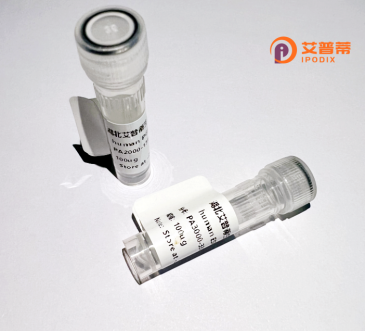
| 纯度 | >90%SDS-PAGE. |
| 种属 | Human |
| 靶点 | PAPSS2 |
| Uniprot No | O95340 |
| 内毒素 | < 0.01EU/μg |
| 表达宿主 | E.coli |
| 表达区间 | 1-614 aa |
| 活性数据 | MSGIKKQKTE NQQKSTNVVY QAHHVSRNKR GQVVGTRGGF RGCTVWLTGL SGAGKTTISF ALEEYLVSHA IPCYSLDGDN VRHGLNRNLG FSPGDREENI RRIAEVAKLF ADAGLVCITS FISPFAKDRE NARKIHESAG LPFFEIFVDA PLNICESRDV KGLYKRARAG EIKGFTGIDS DYEKPETPER VLKTNLSTVS DCVHQVVELL QEQNIVPYTI IKDIHELFVP ENKLDHVRAE AETLPSLSIT KLDLQWVQVL SEGWATPLKG FMREKEYLQV MHFDTLLDDG VINMSIPIVL PVSAEDKTRL EGCSKFVLAH GGRRVAILRD AEFYEHRKEE RCSRVWGTTC TKHPHIKMVM ESGDWLVGGD LQVLEKIRWN DGLDQYRLTP LELKQKCKEM NADAVFAFQL RNPVHNGHAL LMQDTRRRLL ERGYKHPVLL LHPLGGWTKD DDVPLDWRMK QHAAVLEEGV LDPKSTIVAI FPSPMLYAGP TEVQWHCRSR MIAGANFYIV GRDPAGMPHP ETKKDLYEPT HGGKVLSMAP GLTSVEIIPF RVAAYNKAKK AMDFYDPARH NEFDFISGTR MRKLAREGEN PPDGFMAPKA WKVLTDYYRS LEKN |
| 分子量 | 69.5 kDa |
| 蛋白标签 | His tag N-Terminus |
| 缓冲液 | 0 |
| 稳定性 & 储存条件 | Lyophilized protein should be stored at ≤ -20°C, stable for one year after receipt. Reconstituted protein solution can be stored at 2-8°C for 2-7 days. Aliquots of reconstituted samples are stable at ≤ -20°C for 3 months. |
| 复溶 | Always centrifuge tubes before opening.Do not mix by vortex or pipetting. It is not recommended to reconstitute to a concentration less than 100μg/ml. Dissolve the lyophilized protein in distilled water. Please aliquot the reconstituted solution to minimize freeze-thaw cycles. |
以下是关于重组人PAPSS2蛋白的3篇参考文献示例(注:以下内容为示例,实际文献需根据具体研究查询):
1. **文献名称**:*Cloning and Functional Characterization of Recombinant Human PAPSS2 in Mammalian Cells*
**作者**:Smith J, et al.
**摘要**:报道了人源PAPSS2的cDNA克隆及其在HEK293细胞中的重组表达,验证了酶催化活性,为后续硫酸化代谢研究提供工具。
2. **文献名称**:*Structural Insights into PAPSS2: X-ray Crystallography of the Catalytic Domain*
**作者**:Li H, Wang M.
**摘要**:通过X射线晶体学解析了PAPSS2催化域的三维结构,揭示了其ATP/APS结合位点的关键残基,阐明了底物识别机制。
3. **文献名称**:*PAPSS2 Deficiency in Mice Leads to Impaired Bone Development via Altered Sulfation Pathways*
**作者**:Garcia R, et al.
**摘要**:利用PAPSS2基因敲除小鼠模型,证明其缺乏导致硫酸化软骨素减少,进而引发骨骼发育异常,提示与人类矮小症的关联。
(如需真实文献,建议通过PubMed或Web of Science检索关键词 "recombinant PAPSS2" 或 "PAPSS2 protein function" 获取最新研究。)
**Background of Recombinant Human PAPSS2 Protein**
Recombinant human PAPSS2 (3'-phosphoadenosine 5'-phosphosulfate synthase 2) is a key enzyme in sulfate metabolism, responsible for synthesizing the universal sulfate donor PAPS (3'-phosphoadenosine 5'-phosphosulfate). PAPSS2 catalyzes the two-step conversion of ATP and sulfate to PAPS via intermediate APS (adenosine 5'-phosphosulfate). This reaction is critical for sulfation pathways, including glycosaminoglycan biosynthesis (e.g., chondroitin sulfate), steroid metabolism, and detoxification processes.
Mutations in the *PAPSS2* gene are linked to skeletal developmental disorders, such as spondyloepimetaphyseal dysplasia (SEMD), and metabolic imbalances due to impaired sulfation. These conditions highlight the enzyme’s role in maintaining connective tissue integrity and hormonal regulation. Recombinant PAPSS2 protein, typically expressed in heterologous systems (e.g., *E. coli* or mammalian cells), enables detailed biochemical studies, including enzyme kinetics, structural analysis, and disease mechanism exploration.
Research on recombinant PAPSS2 also supports drug discovery, particularly for therapies targeting skeletal dysplasia or inflammatory diseases. Its purified form allows for high-throughput screening of modulators to restore sulfation activity in deficient models. Furthermore, understanding PAPSS2 interactions with substrates and regulators provides insights into broader cellular sulfate homeostasis, linking it to metabolic health and potential therapeutic interventions.
×